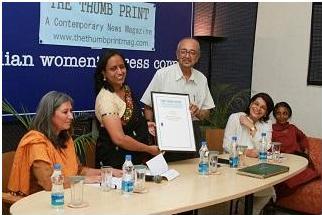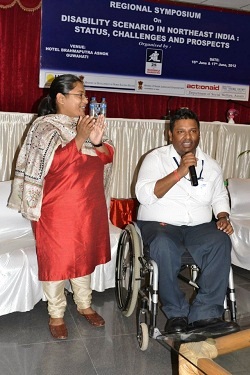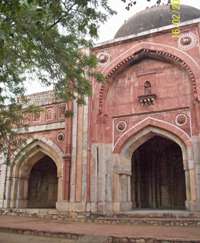I have said this before, as I move around in Bangkok city, many things remind me of home, of Guwahati. Most of them are binary opposite in nature. If Bangkok is clean and orderly, Guwahati is dirty and chaotic. If Bangkok is polite and quiet, Guwahati is rude and loud. If Bangkok has variety and acceptance, Guwahati is limited and intolerant...
A visit to the Asian Institute of Technology evoked a irregular thought for the first time - 'oh! It's like home. Or maybe worse! 'And no, it is not the fault of AIT that I had such thoughts. It is what it has been through. Flood!
I had gone to AIT near Bangkok to see a friend. She warned me on the phone, 'I cannot do any cooking. I lost all my pots and pans in the flood.' And it open a floodgate (could not miss that opportunity for a pun) of memories! For what memories of Guwahati will be complete if it did not have a scene from flooded nights and days where your roads turns into rivers and you swim through piles of garbage to reach home or sometimes someone else's home. For your home is deeper underwater than your lucky friends or relatives who are the unlucky ones that night for they have to feed and water you.
Bangkok like our Guwahati sits pretty along a river. Theirs is called Chao Phraya - the chief river of the kingdom of Siam. From the time of the kings and merchants Chao Phriya has been played with a lot. The engineers of the Ayutthaya diverted it into canals to shorten their journey into the see through the river and to reach places around Bangkok with their merchandise.
Till the 19th century the visiting foreigners were calling Bangkok the 'Venice of the East' because of its many canals. These canals were the main public transport channels of the city. As modernization happened and Toyota and Ford had to expand their business, these canals gradually started getting filled up to make way for roads and buildings. Barring a few left over and smelly ones, the city now has none of its waterways left. Chao Phraya however continues, to be the 'main artery' of transport to Bangkok. Boats, river buses, boat cruises, floating restaurants bring in the elements of enjoyment to the people. Ships and big boats bring in the gear for the city.
In 2011, the Chao Phraya brought in floods to Bangkok. A tropical storm in the northern part of Thailand that July resulted in heavy rainfall of no precedence. Provinces that lay north and east of Bangkok started getting flooded. Soon the flood reached the mouth of Chao Phraya and started moving towards the one time Venice of the East. The authorities, unprepared that they were, built sand banks around Bangkok to save the capital city. This did save the city's business centre from getting inundated but nearby areas like Rangsit where the AIT is got flooded and stayed that way. For months.
In 2012, when I was visiting the friend at AIT she was still living in her rented apartment in the middle of the city. She like thousands of others had to leave their housing and belongings as and where they were and find places and people to live with during the floods. Initially people thought the water would recede in a day or two and they would be able to go back home. The days turned into weeks and the weeks into month. Places remained underwater as the natural flow of the river was blocked and from friends' and relatives' people had to look for rented houses.
My friend showed me around AIT where the water remained blocked with no place to recede for around 6 months! The water level at that place rose up to 10 feet. I tried to imagine the sprawling green campus with huge open spaces as a lake. Many of the old trees had died. The trees still had watermarks up to their branches. Below the residential quarters of the institute, damaged vehicles lied damaged beyond repair. It reminded me of that time in Guwahati when I had to catch a train a rainy morning.
The night before was a friend's birthday. As heavy rain poured, Guwahati streets started getting flooded. From Lachit Nagar we had reach Ganeshguri. We tried G.S. Road. It was flooded. We wanted to try Zoo Road. People laughed at us told us not even to think about it. I still remember that watery darkness where every lane between G. S. Road and Zoo Road had turned into torrential rivers. The water flowed with tremendous force entering who knows how many people bedrooms, kitchens, toilets. Finally in the wee hours of the morning the friend and I decided to brave the waters. We drove through the rivers in her newly acquired Kinetic Honda. At some places the water was till our chest. I did manage to catch the train thanks to foolish bravery only youth guarantees. But every time we talk about that morning we still wonder how did we manage to drive under all that water without the scooter halting even once? I would thank Kinetic Honda too but it does not exist anymore.
But Bangkok is an exotic city. The news of Bangkok floods was also exotic. While in Guwahati during floods all we get to see is dead dogs and garbage floating around, in Bangkok they saw crocodiles and cobras. Along with disease and damage, people faced threats from crocodiles that fled their parks and landed in people's water logged lawns and swimming pools. No, I am not joking.
Jokes apart, although the flood news made me feel like we are better practiced at handling floods in Guwahati, there are some serious issues that emerged which are relevant to Guwahati too.
The Bangkok floods were taken very seriously by the international community. The World Bank and Asian Development Bank etc went into immediate assessment and action. They estimated more than one thousand billion Thai baht worth of damage was caused by the flood. Some predicted that in the next twenty years the Thai government will have to spend many more thousand billion Thai baht to protect their capital city. For Bangkok, built on marsh land just like our Guwahati, is sinking. Experts estimate that Bangkok's flood risks will increase 4 folds by 2050. Global warming which is causing sea level to rise puts Bangkok amongst 10 capital cities at highest risk from raising sea level.
Experts also say that heavy pumping of ground water is another reason why Bangkok is sinking. In 1970, the experts estimated that Bangkok was sinking at the rate of 10 cm per year due to ground water pumping! The government was quick to respond to this urgency and they made policies to stop ground water pumping. The sinking rate has been reduced to around 1 cm per year since then.
Bangkok has a system of canals, drains, rivers etc to drain out flood water, but the 2011 floods caught everyone unprepared for such huge amounts of water.
In Guwahati, although we do not have thousands of billions of Thai baht to be damaged in flood, we are at equal risk from impacts of global warming and natural siltation of the river Brahamputra. According to experts who have been studying the Brahmpautra, our great river is one of the highest silt accumulating rivers in the world. As a result it is becoming shallow every year. A shallow river bed means rising water level. And if we block the river's banks with buildings and concrete construction it only means the water will overflow into our houses one day. If you follow the flood news in details, each year new areas of Guwahati gets flooded. Places like Kharghuli which are hilly, still got flooded last year. A bad sign is it not. Apart from cutting down hills and filling up low lying catchment areas, we have also been pumping ground water like there is no tomorrow. All over the world (and in other parts of India) it has been seen that pumping of ground water causes the ground to sink. This is no conspiracy theory. It is basic physics. What hold the ground from underneath are the layers of soil, rock and water. If you remove any one of these layers naturally the top will sink.
When I look around Guwahati and the rampant construction mania that has engulfed the city, I imagine a sinking city. In Kharghuli, next to my house, there is a building being constructed for which they are breaking down massive rock face. This rock, known as Hatixil (elephant rock), is the one that protects the nearby hills from the river. What kind of sensibility allows people to do that? What policies regulate such practice that puts the entire city under threat of destruction? The time has come and we can learn from our neighbor, unless you envision a different, safe, sustainable future, concrete constructions will not protect us from fury of nature. We need policies and laws that prevent destruction of our environment. We need to stop the corruption that is eating up the city from under. At least in Bangkok, they have international sympathy and interest. In Guwahati we have greed and shortsightedness and in times of trouble these won't help at all.







































